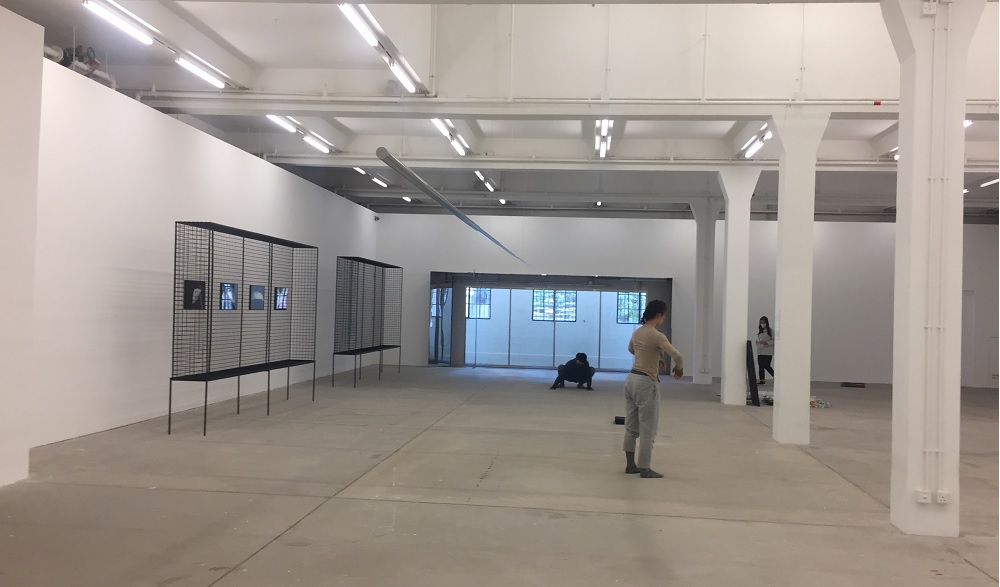Reviews & Articles
Review My Body Holds Its Shape at Tai Kwun Contemporary
Jonathan THOMSON
at 12:49pm on 21st January 2021

Caption:
My Body Holds Its Shape, Tai Kwun Contemporary
(原文以英文發表,評論「承受著自身的姿態」展覽,大館當代美術館。)
The exhibition My Body Holds Its Shape at Tai Kwun Contemporary contains a curious collection of objects:
A 12 metre long needle made up of a telescoping series of brushed steel pipes one nesting inside another ranging from some 70mm in diameter down to 3mm at its point.
A small stack of black linen placemats held together in a loose bundle with string and a second similar bundle of placemats in a range of bright colours.
A white pipe painted with a spiral that has been inserted into the wall at a corner and motorised to rotate slowly along its length.
Two polaroid photographs of a man minding a vacant parking space in front of a row of shops, each shop with an awning offering the interior some protection from the elements.
A large flat screen showing a video of a dancer dressed in pink bra and black panties working through a series of vigorous exercises.
A group of three metal sculptures, one a low barrier made of lengths of square sectioned steel painted black, another an impractical rectangular table-like object made using a sway shaped film of brass supported on spindly legs, and the third a narrow steel table on shaped legs supporting two sheets of glass leaning against the wall.
Two large black steel mesh box frames on low legs, one containing a series of four photographs of shiny metal objects nestling on vegetation and reflecting the sky.
A pile of used lighting devices littering the floor including candles, tea lights, light globes, fluorescent tubes, floodlights, cigarette lighters and a flat screen monitor.
A large lightbox photograph of a 7-11 store at night.
A set of steel and glass shop windows set into the wall of the gallery affording a view into a back of house corridor and beyond to real windows into the outside.
A rectangular block of metal standing like a stele, polished mirror bright on one side and fused, pitted and accreted on the other.
Two fit young people adopting a series of yoga-like poses in various locations throughout the gallery, at times fixing the visitor with a disconcerting stare and at others making a series a rasping gasps.
In the brochure accompanying the exhibition My Body Holds Its Shape,curator Xue Tan posits that the exhibition assumes the metaphorical shape of a body. When populated with visitors the space can then be seen to contain various biological processes and intelligences and its four walls forming a skin that separates it from the rest of the world.
Whist the same claim could be made for any room anywhere, when armed with this knowledge we may see the steel needle by Georgian artist Thea Djordjadze as representing our moral compass; the shop windows, also by Djordjadze, as eyes; the rotating spiral-painted pipe by Hong Kong artist Tap Chan as representing the regularity of unconscious bodily processes such as heartbeats or breath; the dancers choreographed by Filipino artist Eisa Jocson and the unchoreographed movement of visitors to the exhibition as biological processes; and the other objects as representing various intelligences and our interactions with others.
These readings may be too simplistic. An explanatory text tells us that Eisa Jocson’s dancers are in fact performing a work entitled Zoo which explores the relations between humans and animals, systems of labour and confinement, and the politics of the gaze and spectacle. This work gains additional resonance during Covid-19 when we are all advised to confine ourselves to our homes and limit our interactions with others. Likewise a text helps the polished metal stele become the most evocative object. The text tells us the stele is made from the remains of the more than two million tonnes of bombs dropped on Laos by the USA during the Vietnam War. One face has been polished mirror bright. The other is scarred and accreted by the melting, fizzing, foaming effects of various chemical and physical processes. Thus one side represents introspective reflection. The other, reality.
